Sat 29 Feb 2020
Animal tales of past developments
Posted by DavidMitchell under West Marin nature, Wildlife
Comments Off on Animal tales of past developments
Caveat lectorem: When readers submit comments, they are asked if they want to receive an email alert with a link to new postings on this blog. A number of people have said they do. Thank you. The link is created the moment a posting goes online. Readers who find their way here through that link can see an updated version by simply clicking on the headline above the posting.

A coyote prowling, appropriately enough, near our coyote brush.
Coyotes were loudly howling Thursday night down at the foot of our cul de sac, creating the impression that something big was occurring. But as the Human-Wildlife Interactions journal explained in 2017, some mistakenly believe howling indicates that a group of coyotes has made a kill.
Coyotes howl for various reasons, and it is not likely because they have downed prey. Doing so would draw attention and might attract competing coyotes or other predators to their location, which is not something a hungry coyote would want to do. Coyotes howl and yip primarily to communicate with each other and establish territory. They may bark when they are defending a den or a kill. When coyotes are noisy, it often creates an exaggerated impression as to how many are on hand, largely because of the mixing of howls and yips.
There were no coyotes in West Marin for 40 years because of poisoning by sheep ranchers in northwest Marin and southern Sonoma counties. However, coyotes never disappeared from northern Sonoma County, and after the Nixon Administration banned the poison 10-80, they started spreading south and showed up here again in 1983. Since then coyotes have put an end to well over half the sheep ranching around Marshall, Tomales, Dillon Beach, and Valley Ford.
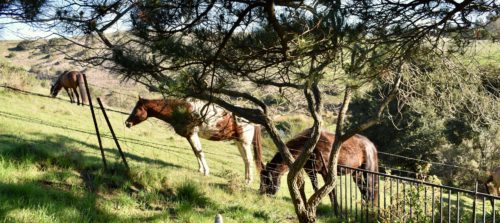
Three horses belonging to Point Reyes Arabian Adventures grazing outside our bedroom window last week.
By chance, I’ve recently listened several times to the Irish singer Van Morrison singing his 1989 composition Coney Island. It’s a pastoral song, which seems to contain an odd reference to cocaine: “Coney Island/ Coming down from Downpatrick/ Stopping off at St. John’s Point/ Out all day birdwatching/ And the crack was good.”
The reality, of course, is that he’s actually saying “craic,” which is a relatively new Irish word for fun or entertainment. It was borrowed in the last century from Ulster and Scotland, where it is pronounced crack.
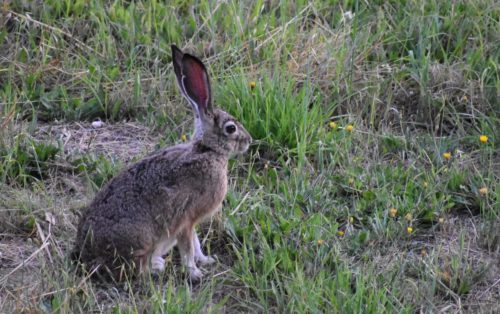
Jackrabbit outside Mitchell cabin.
Coney Island in Van Morrison’s song does not refer to the amusement park in Brooklyn but to an island off County Sligo on the west coast of Ireland. And here’s where the story gets interesting. By most accounts, Dutch settlers named Ireland’s Coney Island after the many rabbits found there, konijn being a Dutch word for rabbit.
In the late 1700s, a merchant ship, Arethusa, regularly sailed between Sligo and New York City. After seeing an abundance of rabbits on a New York island, Peter O’Connor, the ship’s captain, named the place Coney Island because it reminded him of the Coney Island in Sligo Bay. During the 1920s and 1930s, Coney Island, New York, became a peninsula when a creek separating it from the rest of the city was filled in.
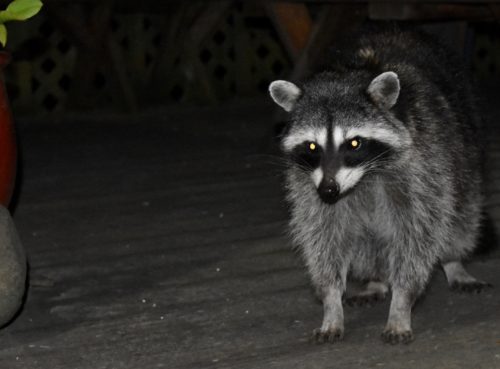
Raccoons are nightly visitors at Mitchell cabin, and I’ve come to see at least two sides of their personalities. They’re cute and able to beg for handouts, but they get skittish if I’m too close, quickly backing away when I open a door. And that’s probably for the best. Over the years, West Marin’s raccoons have prompted numerous calls to the Sheriff’s Office from people who thought they heard a prowler on their porch or roof at night.
Skunks drop by Mitchell cabin most nights, aggressively competing with the raccoons for food. They don’t spray but forcefully shoulder aside raccoons, even though the latter are noticeably bigger. I’m fascinated by all this and find it shameful how misguided county policy towards the two species was six decades ago. In 1958, Marin County supervisors began offering $1 bounties for skunk and raccoon tails. Fortunately after three weeks, the board reversed itself and dropped the offer, not because it was cruel but because young hunters with small-bore rifles were shattering too many windows.
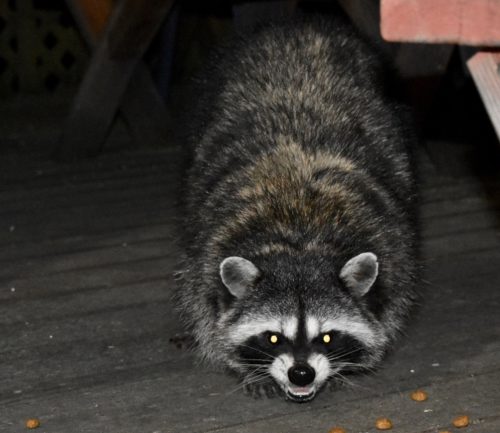
Despite appearances, this raccoon is not trying to look fierce. It’s merely chomping down hard on a piece of kibble.
If raccoons show up on our deck wanting to be fed and realize we don’t know they’re out there, some will make us see them through our living room windows by standing on their hind legs atop a small bench or the woodbox and staring in at us. If we still don’t see them, they often create a squeal by dragging the pads of their front paws down the glass.
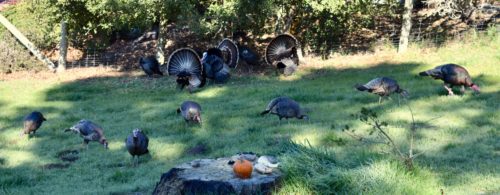
Wild turkeys are native to Canada, Mexico, the American Midwest, and the East Coast but not West Marin although they are now found throughout this area. In the 1950s, the state Department of Fish and Game released some wild turkeys in Napa County because they were so popular with hunters. In 1988, Fish and Game biologists took a few birds from the Napa flock and released them on Loma Alta Ridge between Big Rock and Woodacre.
Few people hunt the turkeys these days, flocks have increased in number and size, and the turkeys have become rather bold. In 2001, two Tom turkeys went after a couple of school children riding scooters in Tomales. The children had to escape on foot, leaving their scooters behind. Now who’s doing the hunting?

No Responses to “ Animal tales of past developments ”
Sorry, comments for this entry are closed at this time.